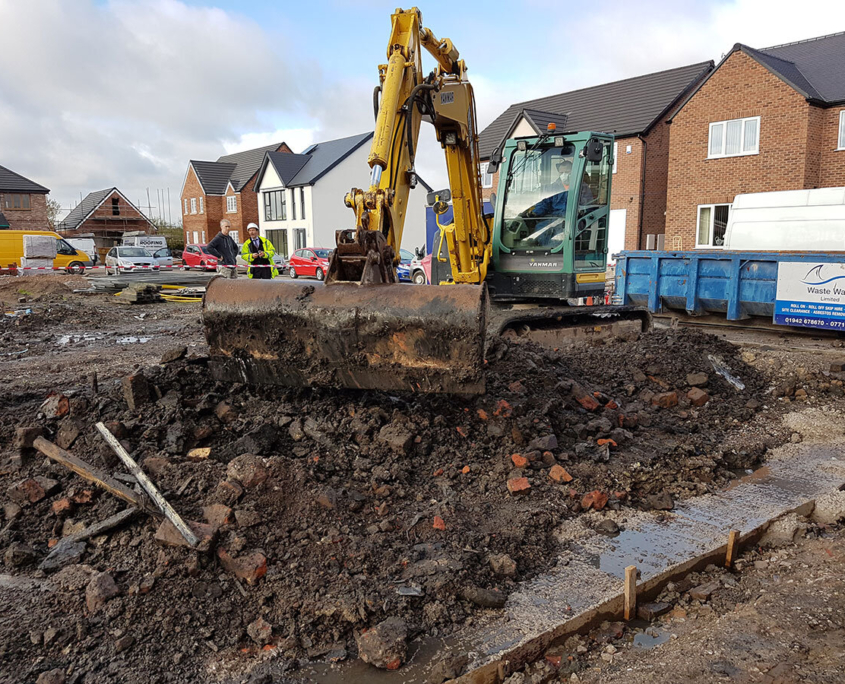Developing Grey Belt Land
Opportunities, Challenges, and Best Practices
What is Grey Belt Land and What Do You Need to Know When Developing a Grey Belt Site?
The Government’s recent proposals to amend the National Planning Policy Framework (NPPF) introduced a relatively new concept of The Grey Belt. The Grey Belt does not refer to the land around an area, like the Green Belt (which was designed to encircle settlements to prevent urban sprawl, encroachment on the countryside, and to keep settlements separate).
The Grey Belt, however, refers to poor-quality and neglected spaces within the Green Belt. These sites were difficult to develop previously as they were situated in the Green Belt. The government’s plan is to allow the development of these previously used and/or unsightly sites to free up land for the construction of new homes.
Examples of this include:
- Disused car parks in Green Belt areas
- Old petrol stations or garages in Green Belt areas
- Sites no longer used because new updated premises were required (e.g., fire stations, public buildings)
For the purposes of plan-making and decision-making, Grey Belt is defined as land in the Green Belt comprising Previously Developed Land and any other parcels and/or areas of Green Belt land that make a limited contribution to the five Green Belt purposes (as defined in paragraph 140 of this Framework), excluding those areas or assets of particular importance listed in footnote 7 of this Framework (other than land designated as Green Belt).
Labour have announced five golden rules for the development of any scheme built on green belt land:-
- Brownfield development must be prioritised ahead of Green Belt;
- Grey Belt development will come next;
- Green Belt development must include at least 50% affordable homes;
- New public services and infrastructure must be introduced when building on the Green Belt;
- Green Belt development must be ‘accompanied by a plan to improve existing green spaces and create new ones accessible to local people’.
At Earth Environmental & Geotechnical we can support you to get planning permission for developing a grey belt site with our comprehensive range of geo -environmental & Geotechnical services. From phase 1 desk study, site investigations and remediation designs we provide a holistic, pragmatic approach to ensure your development is built safely and cost effectively. Having a detailed understanding of ground conditions is the essential first step to your developments success. Assess soil and rock properties, environmental quality, and potential contamination risks for informed decision-making. Mitigate potential hazards like unsuitable ground conditions or contamination.
As more Grey Belt sites and Brownfield Sites are developed for regeneration projects and housing, the need for efficient cost effective solutions on how to develop these sites safely and responsibly is essential.
Contact us now to discuss your development site and how we can support your Grey Belt land development cost-effectively and responsibly.
Remember an essential first step in all development is to understand the ground conditions of the site
Why Site Investigations are Essential for Grey Belt Development
Introduction to Site Investigations
Site investigations are a crucial step in the development of Grey Belt land. These investigations help identify potential risks, determine the suitability of the site for development, and provide valuable data for informed decision-making. Thorough site investigations ensure that projects are both feasible and sustainable, minimising unforeseen challenges during the construction process.
Understanding Site Conditions
Grey Belt land, being situated between urban and rural zones, often presents unique site conditions. The proposed reforms for Grey Belt development prioritises previously used land. As such these sites may be contaminated due to historic or previous activities, requiring clean up or remediation. So having a detailed understanding of the development site helps to identify potential hazards and optimise your development’s design with comprehensive ground data.
Early Site investigations and risk assessments can save valuable time and money.
These areas can have varied topography, soil types, and water tables. Comprehensive site investigations help developers understand these conditions, ensuring that the land is suitable for the intended development and that any potential issues are identified early on.
Regulatory Compliance
Regulatory compliance is a significant aspect of Grey Belt development. Local authorities often require detailed site investigation reports as part of the planning and approval process. These reports demonstrate that developers have conducted due diligence and are aware of any environmental, geological, or structural challenges that might affect the project.
Risk Mitigation
By conducting thorough site investigations, developers can identify and mitigate risks associated with Grey Belt land development. This includes understanding the potential for soil contamination, assessing flood risks, and evaluating the stability of the land. Early identification of these risks allows for the implementation of appropriate mitigation measures, reducing the likelihood of costly delays or complications during construction.
Key Components of Site Investigations for Grey Belt Development
Geotechnical Investigations
Geotechnical investigations focus on understanding the physical properties of the soil and rock beneath the site. These investigations typically include:
- Soil Testing: Analysing soil samples to determine composition, density, and strength
- Groundwater Analysis: Assessing the water table levels and potential for water ingress
- Slope Stability: Evaluating the stability of any slopes or embankments on the site
Environmental Assessments
Environmental assessments are critical for identifying any potential environmental hazards or constraints. These assessments often involve:
- Contamination Surveys: Testing for the presence of contaminants such as heavy metals, hydrocarbons, asbestos, PFAS
- Ecological Surveys: Identifying any protected species or habitats that may be affected by the development
- Flood Risk Assessments: Evaluating the potential for flooding and the impact on the proposed development
Archaeological and Heritage Surveys
Given the historical nature of many Grey Belt areas, archaeological and heritage surveys are often required. These surveys help identify any significant archaeological finds or heritage features that need to be preserved or protected during development.
Utilities and Infrastructure Assessments
Understanding the availability and condition of existing utilities and infrastructure is essential for Grey Belt development. This includes:
- Utility Mapping: Identifying the location of existing utility lines (water, gas, electricity) and assessing their capacity
- Infrastructure Assessments: Evaluating the condition of existing roads, drainage systems, and other infrastructure elements
If You Are Thinking of Developing on Grey Belt Land
What do you need to know?
Best Practices for Conducting Site Investigations
Engage Qualified Professionals
Engaging qualified professionals, such as geotechnical engineers, environmental consultants, and archaeologists, is essential for conducting thorough and accurate site investigations. These experts bring the necessary knowledge and experience to identify potential issues and provide reliable recommendations.
At Earth Environmental & Geotechnical Ltd our team can provide all the services required to support your grey belt land development.
Comprehensive Data Collection
Comprehensive data collection is the foundation of effective site investigations. This involves gathering detailed information through field surveys, laboratory testing, and historical research. The more data collected, the better the understanding of the site’s conditions and potential challenges.
Early and Continuous Investigations
An ideal first step to identify the suitability of the grey belt site for development is a phase 1 desk study with a site walkover. This should be part of the initial due diligence process. Initiating site investigations early in the planning process allows for the early identification of potential issues and the development of appropriate mitigation strategies. Continuous investigations throughout the development process ensure that any new findings are promptly addressed.
Stakeholder Collaboration
Collaborating with stakeholders, including local authorities, community groups, and utility providers, is crucial for successful site investigations. Engaging stakeholders early helps address concerns, ensures compliance with regulations, and fosters positive relationships that can facilitate the approval process.
Conclusion
Site investigations are a critical component of Grey Belt development, providing the necessary insights to make informed decisions and mitigate risks. By understanding site conditions, ensuring regulatory compliance, and identifying potential hazards, developers can pave the way for successful and sustainable projects.
Investing in thorough site investigations not only safeguards the development process but also contributes to the success of responsible sustainable new housing development.
More About Earth Environmental & Geotechnical Ltd.
We have worked on a huge array of your sites, from former gasworks, Victorian reservoirs, sewage works, battery storage facilities, renewable energy projects, asbestos factories, electricity sub-stations, collieries, fuel retailing stations, airports, abattoirs, quarries, landfills, etc.
Our services have been used to assist in securing planning pemission and for the the planning and design of new retail stores, housing projects, renewable energy, windfarms solar projects, landfills, quarries, and the restoration of numerous brownfield sites.
We deliver, and take pride in, providing cost effective and pragmatic geotechnical and environmental solutions from our 12 offices in Bath, Cardiff, Edinburgh, Inverness, Stockport, Maidstone, Reading , Exeter, Southampton, Norwich, Birmingham and Wilton.
All of our offices are run by highly experienced Directors, backed by degree qualified staff.
Contact Us now to discuss your project
We have also completed extensive site investigation and ground investigation services in various locations throughout the UK to support new developments and construction
- trial pits
- rotary drilling
- in-situ plate bearing
- Cable Percussive Boreholes
- Window Sample Drilling
- Deep Window Sample Borehole
- Rock Coring
- Rotary Boreholes
- Rotary Core Drilling
- Dynamic Probing
- Trial Pits
- Trenches
- Windowless Sampling Rig
- Soakaway Testing
- Modular windowless sampling drilling rig
- Infiltration tests
- Ground penetrating radar
- Soil Sampling
- Radon Monitoring
- Earthwork Modelling
- Contaminated Land Assessments
- Material Management Plans






